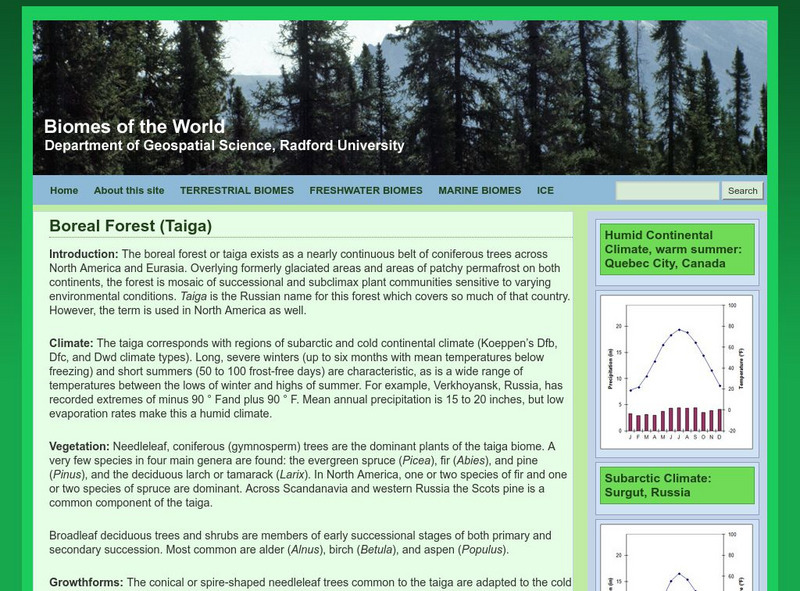Palomar Community College District
Major Biomes of North America
A good review of basic terminology followed by descriptions and pictures of the North American biomes.
Other
Radford University: Taiga or Boreal Forest
This site provides a thorough fact sheet of a taiga forest (or boreal forest as it is otherwise known). Content includes a look at the forest climate, vegetation, growth forms, and soil. Additional information can be found on the alpine...
Environmental Education for Kids
Eek!: Evergreens
Site chronicles Wisconsin's Evergreen and Conifer trees. There are descriptions of the various tree types. Additionally, site details the uses of these trees in nature. Ideal for grades 4-8.
Other
Geography Tutor: Vegetation
A list of questions about vegetation regions for your students to answer.
Other
42 Explore: Trees and Forests
This is a site with links covering multiple areas of tree and plant study. Great illustrations and information.
University of California
Ucmp: Forest Biome
Learn all about the forest biome including where located in the world, different kinds, climate, flora and fauna, and soil. Good research site for middle years students.
PBS
Nh Pbs: Nature Works: Red Squirrel
The common red squirrel is found throughout most of North America in coniferous, deciduous and mixed coniferous-deciduous forests. This site features information ranging from characteristics, life cycle, diet, behavior, range and habitat.
Other
Elm Care: How Trees Work
How do trees drink, how do trees breath, what is the structure of a tree? Answer these questions and more.
Smithsonian Institution
National Museum of Natural History: American Mammals: Cinereus Shrew
Mainly nocturnal and rarely seen, the Cinereus Shrew is nonetheless common and widespread below the timberline in northern deciduous and coniferous forests, in both wet and dry habitats. It is also known as the Masked Shrew and the...
Smithsonian Institution
National Museum of Natural History: American Mammals: White Footed Mouse
The White-footed Mouse has a very wide distribution. It is the most abundant rodent in mixed deciduous and coniferous forests in the eastern United States, and is probably equally abundant near farms. Learn more about the Peromyscus...
Smithsonian Institution
National Museum of Natural History: American Mammals: Eastern Small Footed Myotis
The eastern small-footed myotis is one of the smallest North American bats. It has a limited range, occurring only in eastern deciduous and coniferous forests. Learn more about the Myotis leibii, more commonly known as an Eastern...
Other popular searches
- Coniferous Deciduous Trees
- Deciduous and Coniferous
- Deciduous vs Coniferous
- Deciduous Coniferous
- Deciduous + Coniferous







